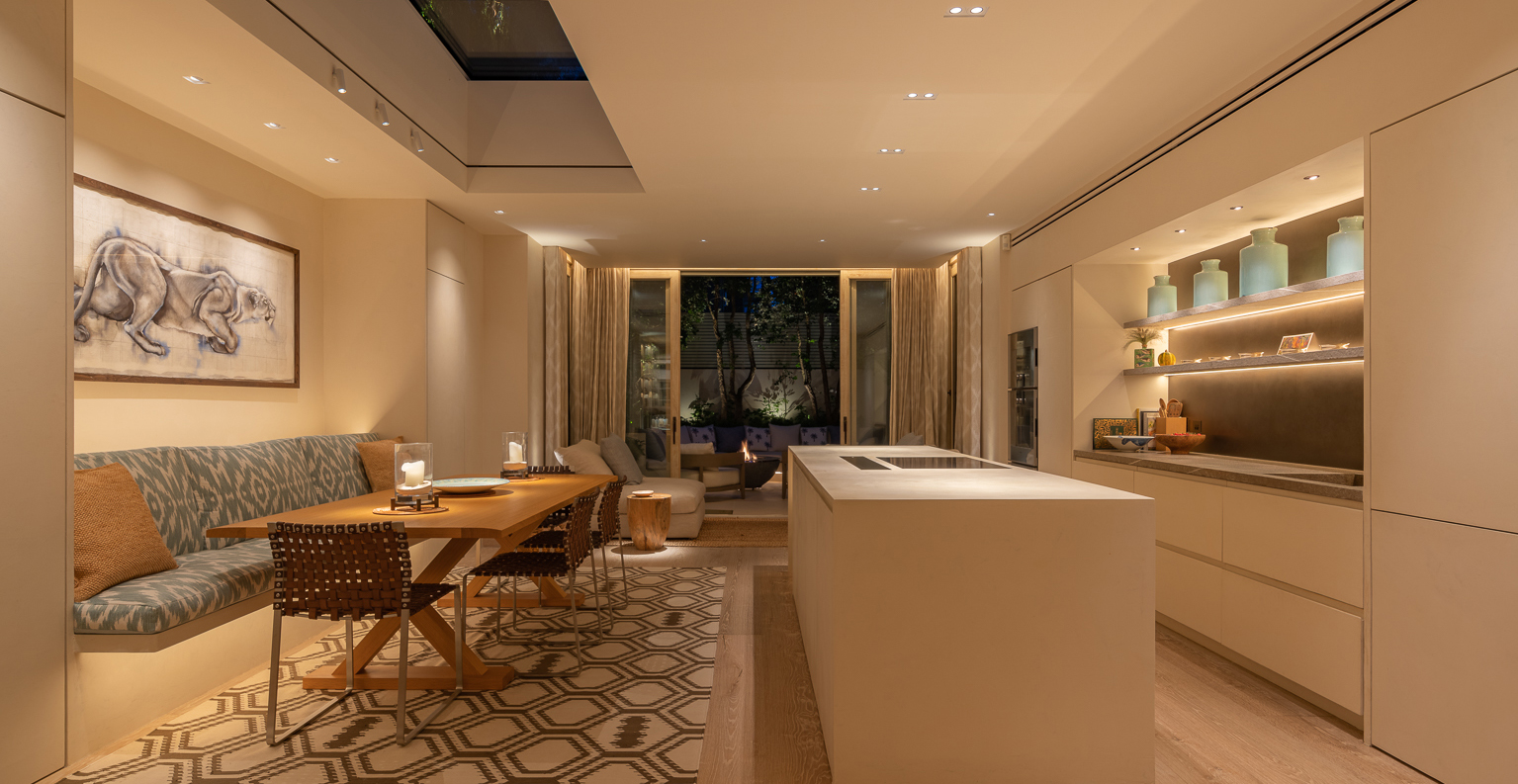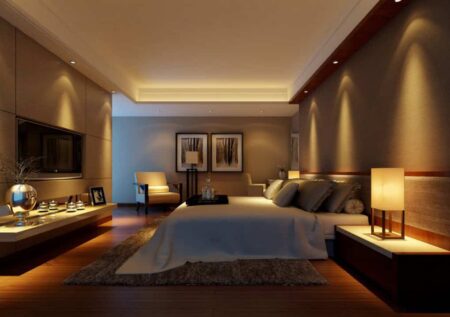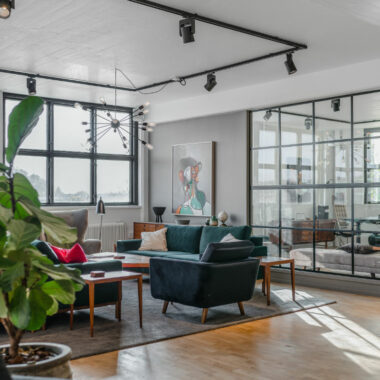Lighting design is an essential aspect of creating a functional and inviting home. Beyond simply providing illumination, a thoughtful lighting plan enhances the atmosphere, highlights key features, and ensures every space serves its purpose effectively. This guide explores the basic lighting design principles, focusing on balancing ambient, task, and accent lighting, creating a layered lighting scheme, and adapting your design for specific layouts like open floor plans.
Mastering Basic Lighting Design Principles
Understanding the foundational principles of lighting is the first step toward designing a well-lit home. Good lighting design requires a blend of three types of lighting: ambient, task, and accent. Each serves a unique purpose, but when combined strategically, they create a harmonious and functional space.
Ambient Lighting: The Backbone of Illumination
Ambient lighting forms the foundation of any lighting scheme. It provides general illumination, ensuring the room is evenly lit and comfortable for everyday activities.
Key options for ambient lighting include:
- Ceiling-mounted fixtures for a uniform glow.
- Recessed lighting for modern and minimalist spaces.
- Large pendants or chandeliers to create a focal point while lighting the room.
Use dimmers with ambient lights to adjust brightness levels depending on the mood or time of day.
Task Lighting: For Focus and Functionality
Task lighting is crucial for areas that require precision, such as reading nooks, kitchen counters, or workspaces. It minimizes eye strain and provides focused illumination for specific activities.
Popular examples include:
- Desk lamps for study or office areas.
- Pendant lights over kitchen islands or dining tables.
- Under-cabinet lighting to eliminate shadows in work areas.
By balancing task lighting with ambient light, you can avoid overly bright or dim spots in your room.
Accent Lighting: Highlighting Features
Accent lighting adds depth and drama to a room by focusing on specific objects or architectural elements. It creates a visual hierarchy, drawing attention to artwork, bookshelves, or textured walls.
Common accent lighting options:
- Track lighting to spotlight art or décor.
- Wall sconces to frame mirrors or add decorative flair.
- LED strip lights for shelves or cabinets.
Accent lighting works best when it complements ambient and task lights, completing the layered design.
How to Balance Ambient, Task, and Accent Lighting
Balancing these three types of lighting is critical for achieving a cohesive design. Start with ambient lighting to establish a consistent base, then layer in task lights where functional illumination is needed. Finally, incorporate accent lighting to add character and highlight focal points.
Pro Tip:
Avoid overloading a room with one type of lighting. For instance, too much ambient light can make a space feel flat, while relying solely on task lighting can result in harsh, uneven illumination.
Creating a Layered Lighting Scheme
A layered lighting scheme involves combining different lighting types to enhance functionality and atmosphere. This technique ensures your home is adaptable to various activities and moods.
Here’s how to create a layered scheme:
- Establish the base with ambient lighting.
This ensures overall visibility and sets the tone. - Add task lighting for practicality.
Focus on key areas like desks, counters, and seating spaces. - Incorporate accent lighting for personality.
Highlight decorative elements or create cozy zones.
For instance, a dining room might feature a chandelier (ambient), pendant lights over a buffet table (task), and LED strips on shelving (accent).
Lighting Design for Open Floor Plans
Open floor plans present unique challenges when it comes to lighting. Without walls to divide spaces, it’s essential to use lighting to define different areas while maintaining visual cohesion.
Strategies for Open Floor Plans
- Define zones with lighting: Use a pendant light to anchor the dining area and recessed lighting for the living space.
- Maintain a consistent style: Choose fixtures with complementary finishes and designs to unify the space.
- Layer lights strategically: Balance ambient lighting with localized task and accent lighting to create depth and dimension.
Dimmers are particularly useful in open layouts, allowing you to adjust brightness levels across zones based on activity.
Maximizing Natural and Decorative Lighting
Harnessing Natural Light
Natural light is an integral part of lighting design. It not only reduces the need for artificial light but also enhances the overall ambiance.
Ways to maximize natural light:
- Opt for sheer curtains or blinds to let sunlight filter through.
- Use mirrors strategically to reflect light and brighten the room.
- Position furniture to avoid blocking windows or light sources.
Using Decorative Lighting for Style
Decorative lighting doubles as a design element. Chandeliers, statement pendants, and sculptural fixtures add flair to a room while contributing to the layered lighting scheme.
Choose decorative fixtures that complement the room’s aesthetic while serving functional purposes, such as providing ambient or accent lighting.
Room-by-Room Lighting Tips

Living Room
The living room is a multipurpose space requiring versatile lighting. Use recessed or ceiling-mounted lights for ambient illumination, table lamps for task lighting, and accent lights to highlight shelves or artwork.
Kitchen
A kitchen needs bright, focused lighting for tasks like cooking. Combine recessed lights for general brightness with pendant lights over islands and under-cabinet lighting for countertops.
Bedroom
Soft, warm lighting is ideal for bedrooms to promote relaxation. Add bedside lamps for reading and subtle accent lights to create a cozy atmosphere.
Bathroom
Bathrooms benefit from bright ambient lights and task lighting around mirrors. Ensure fixtures are rated for damp conditions to prevent issues with moisture.
Choosing the Right Bulbs and Fixtures
Selecting appropriate bulbs and fixtures is as crucial as the design itself.
- Warm tones (2700K–3000K): Ideal for living rooms and bedrooms.
- Cool tones (4000K–5000K): Best for kitchens, offices, and bathrooms.
- LED bulbs: Energy-efficient, long-lasting, and versatile for any lighting need.
Ensure fixtures are placed strategically to avoid glare and shadows while maximizing the room’s functionality.
Conclusion
Mastering lighting design basics transforms a house into a home, blending form and function in every room. By applying the basic lighting design principles, balancing ambient, task, and accent lighting, and tailoring your design to unique layouts like open floor plans, you can achieve a harmonious and visually stunning environment.
Start with a solid foundation, layer your lights thoughtfully, and experiment with decorative elements to add personality to your space. With these strategies, you’ll create a home that shines—both literally and figuratively.
















